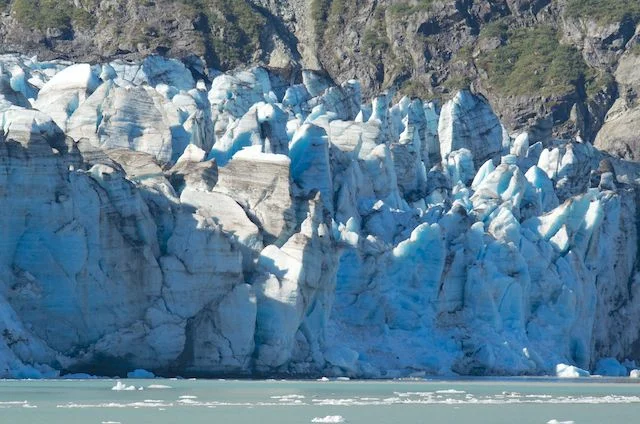This was to be another glorious day, with the bluest sky imaginable and not a cloud to be seen till later in the day.
At dawn we awoke to find ourselves anchored at the toe of Margerie Glacier at the northernmost part of Tarr Inlet at the top of Glacier Bay.
As the sun rose higher in the sky the 800 m long glacier face which is 80 m high became totally bathed in sunlight causing the ice to glisten and some melting resulted in pieces calving off. The largest ice fall we observed in the hour we were present would have been a piece 50 m by 30 m which topped from near the iceberg’s top leaving a huge hollow section. The wave produced by this calving caused nearby icebergs and the boat to ride a big swell for a minute or two.
After breakfast we headed back down Tarr Inlet and rounded Russell Island by passing through a tight squeeze where the state of the tide enabled us to pass safely. The depth was not the concern but the huge water flow between high and low tides causes dramatic currents in this narrow channel. We observed a bear and her 2 cubs strolling along the foreshore but they disappeared into the trees before we could get close enough to see them properly.
Our next manoeuvre was north-west past Lamplugh Glacier and around Jaw Point into John Hopkins Inlet. Another very large cruise ship (3000 passengers?) was in the area but it was too large to proceed beyond Jaw Point.
We then headed further up the inlet to a point some 500 m from the John Hopkins Glacier’s face to a point where the number of small icebergs made further movement difficult for the ship’s captain.
The scene was unsurpassed in terms of ice colours, sky clarity and mirror calm waters so our cameras worked flat out for quite a time. On either side of the fjord were towering mountains with several smaller glaciers perched on high cliffs. Forming a backdrop to the John Hopkins Glacier were two pyramidal shaped, snow-capped peaks being Mt. Wilbur and Mt. Orville. (I hope that’s ‘Wright’?)
Just sitting there quietly in the sunshine was a magic experience and we felt blessed with the perfect weather as others had told of days where nothing was visible here due to rain, fog and gloom!
After a light luncheon we cruised down Glacier Bay searching the shoreline, islands and inlets for wildlife. There were the usual porpoises, otters, many different sea-birds, a humpbacked whale and several fluffy white mountain goats wandering high on the precipitous cliffs above us. A group of seven tufted puffins were sighted in the water ahead of the boat but they fled as we approached.
After a brief detour into Geikie Inlet to search for more puffins we then passed by South Marble Island where a very large steller sea-lion colony was located and then sailed further south to Bartlett Cove where the “Sea Bird” tied up.
After dinner we went ashore and did a one-hour twilight walk through the forest behind the visitors centre. Our naturalist guide William, found four different species of orchid and showed us glacial ‘kettles’ which are shallow ponds formed by different levels of earth rising after a glacier melts.
At the visitors’ centre was a large and very well presented skeleton of a female
humpback whale which was unfortunately killed by being hit with a cruise boat propeller!
We then spent an enjoyable hour or so at the Glacier Bay Lodge in Bartlett Cove chatting with fellow travellers before heading back to the boat which was due to depart port at 2300. This has been a day of visual superlatives; the scenery inside John Hopkins Inlet and Glacier Bay was more spectacular than one could have ever imagined. Wow!
Overnight we’ll head south out of the 134,000 km2 Glacier Bay National Park and move down towards Chichagof Island.










